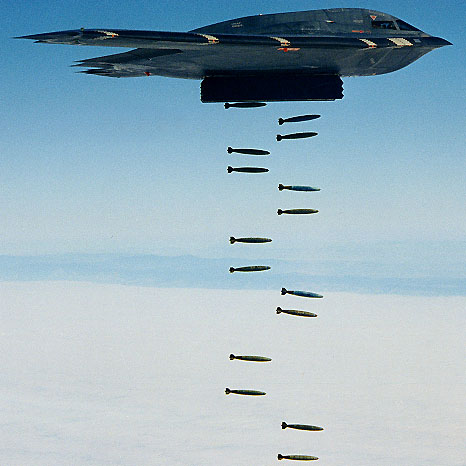
| Submit your comments on this article |
| Iraq |
| 99 Iraqi attacks used Iran supplied bombs in July says US |
| 2007-08-10 |
| Attacks on U.S.-led forces using a lethal type of roadside bomb said to be supplied by Iran reached a new high in July, according to the U.S. military. The devices, known as explosively formed penetrators , were used to carry out 99 attacks last month and accounted for a third of the combat deaths suffered by U.S.-led forces, Lieutenant General Raymond Odierno, second in command in Iraq, said in an interview. Such bombs, which fire a semi-molten copper slug that can penetrate the armor on a Humvee and are among the deadliest weapons used against U.S. forces, are used almost exclusively by Shiite militants. U.S. intelligence officials have presented strong evidence that the weapons come from Iran's Islamic Revolutionary Guard Corps, although Iran has repeatedly denied providing lethal assistance to Iraqi groups. In recent weeks, the U.S. military has focused on mounting operations in sanctuaries used by Al Qaeda in Mesopotamia, a Sunni group that is predominately made up of Iraqis but which has foreign leadership. But, as the information provided by Odierno shows, Shiite militias remain a major long-term worry. In focusing on Al Qaeda in Mesopotamia, the U.S. goal is to reduce the number of car bomb and spectacular suicide attacks that have aggravated sectarian tensions, encouraged Shiite retaliation and undermined efforts to encourage political reconciliation. While the group is seen by the U.S. military as the most serious near-term threat, there are other indications that Shiite militias remain active. According to Odierno, who serves as the day-to-day commander of U.S. troops in Iraq, 73 percent of the attacks that killed or wounded U.S. troops in Baghdad in July were carried out by Shiite militants. Although explosively formed penetrators account for a small fraction of roadside bomb attacks in Iraq, they cause a disproportionately large number of casualties. Of the 69 U.S.-led troops killed in action in July, the lowest toll in months, 23 died as a result of attacks with the devices, according to data supplied by Odierno's command. Of the 614 coalition troops who were wounded that month, 89 were hit in penetrator attacks. "July was an all-time high," said Odierno, referring to strikes with such devices. Penetrator attacks have been a worry for years. In 2005, the United States sent a private diplomatic protest to Tehran complaining that Iran's Revolutionary Guards and the Iranian-backed Hezbollah had been training Iraqi Shiite insurgents in Iran and providing them with bomb-making equipment. U.S. intelligence says that its report of Iranian involvement is based on a technical analysis of exploded and captured devices, interrogations of Shiite militants, the interdiction of trucks near Iran's border with Iraq and parallels between the use of the weapons in Iran and in southern Lebanon by Hezbollah. Some critics of Bush administration policy, saying there is no proof that the top echelons of Iran's government are involved, accuse the White House of exaggerating the role of Iran and Syria to divert attention from its own mistakes. According to U.S. military data, penetrator attacks accounted for 18 percent of combat deaths of Americans and allied troops in Iraq in the last quarter of 2006. The number of such attacks declined in January, and some U.S. officials thought at that time that this might be a response to their efforts to publicly highlight the allegations of an Iranian role. But in recent months such attacks have steadily risen. The July figure is roughly double the number for January. The July total is also 50 percent higher than in April, when there were 65 penetrator attacks, according to U.S. military officials. Many of the penetrators encountered by U.S. forces are difficult to counter. Because they fire from the side of the road, the militants do not need to dig a hole to plant them, making them well suited for urban use. Because they are set off by a passive infrared sensor |
| Posted by:Fred |
| #5 OP, as you grow increasingly selective about whom you would nuke and when, you grow evermore persuasive. Pakistan and Iran remain the only two legitimate first use targets I can readily confess to. Both of them have earned it in spades, if not positively begged for it on bended knees. |
| Posted by: Zenster 2007-08-10 18:31 |
| #4 IRAN is one place I'd be willing to nuke, especially Qom, Isfahan, Natanz, and a couple of other, less-well-known sites. We'd then have to take out everything along the Iranian coast of the Persian Gulf. That includes quite a number of artillery sites, about 30 SILKWORM missile sites, hundreds of small boats, submarines, and other dangers to civilian shipping, and quite a few of the Revolutionary Guards. Bushire and Kharq Island can be neutralized by conventional weapons. The entire coastline, however, will have to be captured and held by military forces. We need a substantially bigger Army and Marine Corps for that - about double what we have now. |
| Posted by: Old Patriot 2007-08-10 15:31 |
#3 Candygram for Aquavelvajad! |
| Posted by: doc 2007-08-10 09:30 |
| #2 If we're not going to bomb the hell out of Iran we might as well arm the opposition groups so Akmed-dinnerjacket can get a real taste of his own medicine. We'll just deny we're doing it. Maybe they will get the hint. |
| Posted by: Intrinsicpilot 2007-08-10 03:31 |
| #1 WORLDTRIBUNE > US SURGE IS WORKING BUT SO IS IRAN'S; and STRATEGYPAGE > Iraqi Govt believes Iran is behind a nationwide campaign/program inside Iraq of assassination targeted agz anti-Shia andor pro-US-Western anti-Iran politicos, be they Shia or not. Iran denies it. |
| Posted by: JosephMendiola 2007-08-10 03:18 |